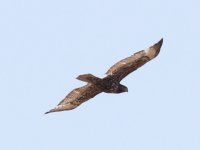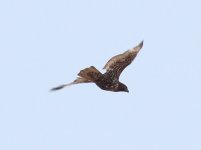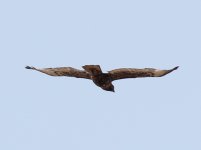khustochka
Well-known member
I spotted this Buteo Hawk on June 2, 2019 in Manitoba, Canada, roughly the south-eastern part.
At first I thought it is some unusual morph of a Red-tailed Hawk, but then I got an idea about Ferruginous Hawk. Ferruginous Hawks are nesting in the far south-western angle of the province, so where I am they are rare but not at all impossible.
What I think is in favour of a Ferruginous (presumably dark morph):
- light tail
- deep brown head and throat without any breast band
- something like a white crescent where the dark colour meets the light on the wing underside
- cannot say if there is a long gape, but the "facial expression" makes me think it is possible
Would appreciate any thoughts. Thank you.
At first I thought it is some unusual morph of a Red-tailed Hawk, but then I got an idea about Ferruginous Hawk. Ferruginous Hawks are nesting in the far south-western angle of the province, so where I am they are rare but not at all impossible.
What I think is in favour of a Ferruginous (presumably dark morph):
- light tail
- deep brown head and throat without any breast band
- something like a white crescent where the dark colour meets the light on the wing underside
- cannot say if there is a long gape, but the "facial expression" makes me think it is possible
Would appreciate any thoughts. Thank you.







